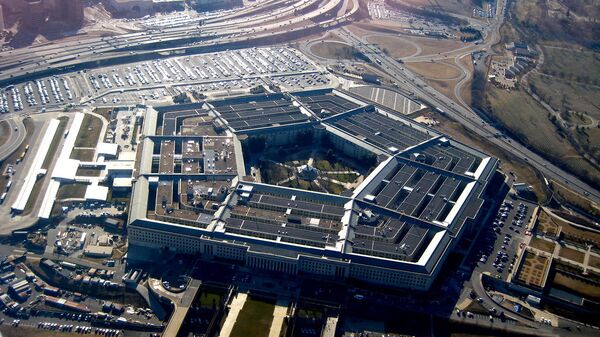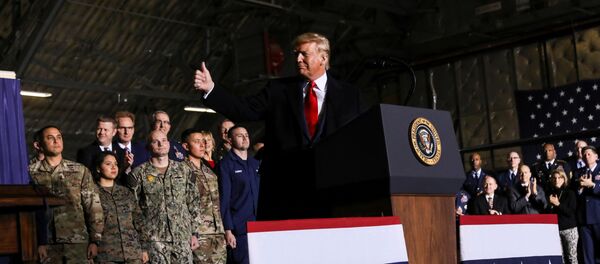Trump has been an ardent supporter of listing space as a new warfare domain. The US president broke the news earlier this year in separate statements, claiming a sixth branch of the US military will detect and destroy any projectile launched against the United States.
Trump reportedly pitched the idea of reviving the Reagan-era 'Star Wars' plan in February 2019. At the time, the US president signed a directive to establish a new Air Force branch - a US Space Force - which would focus on global surveillance, missile targeting and countering Chinese and Russian hypersonic weapons, among other priorities.
NATO Secretary-General Jens Stoltenberg has stressed that the bloc recognizes space as an operational domain but the alliance would not deploy any weapons into Earth orbit or beyond. It remains unclear, however, how the US - a prominent NATO member - will stick to Stoltenberg's promise after the enactment of the NDAA.
The Russian military has said that by creating a space command, the United States is also creating preconditions for militarizing space. Russia has vowed to respond to these actions in kind.
Don DeBar, a US-based pundit, downplays Trump's announcement, saying it is more "a formalization than an invention", citing the prolific record of historic space exploration by Soviet Russia and the US.
"It is more a formalization than invention. The exploration of outer space by the US and the Soviet Union was able to find the resources needed because the development of space technology was, in the age of ICBMs, the development of cutting edge military technology. The first American rockets were developed not to send people or equipment into outer space, but to send bombs to its military adversaries. Soviet rockets were designed to protect the USSR from attack by American rockets. Both found their earliest models in the military laboratories of Nazi Germany", DeBar explains.
The political commentator details the background of gradual space exploration, emphasizing the timing of establishing its military foothold.
"Shortly after the launch of Sputnik in October 1957, the UN's Committee on the Peaceful Uses of Outer Space (COPUOS) was established (in 1958) as an ad hoc committee. In 1959, it was formally established by United Nations resolution 1472 (XIV). Its mission is "to review the scope of international cooperation in peaceful uses of outer space, to devise programmes in this field to be undertaken under United Nations auspices, to encourage continued research and the dissemination of information on outer space matters, and to study legal problems arising from the exploration of outer space", the pundit says.
DeBar also specifies the legal side of the issue.
"Nearly a decade later, the Outer Space Treaty (formally the Treaty on Principles Governing the Activities of States in the Exploration and Use of Outer Space, including the Moon and Other Celestial Bodies), a treaty that forms the basis of international space law, was joined by the United States, the United Kingdom, and the Soviet Union, and entered into force on 10 October 1967. As of June 2019, 109 countries were parties to the treaty, while another 23 had signed the treaty but had not completed ratification", DeBar states.
The commentator recounts an abundant list of agreements that cannot be excluded from the detailed narrative because of their crucial role in the current shaping of space as a potential warfare domain.
"There were a number of other international agreements regarding space that followed: The Rescue Agreement of 1968, an international agreement setting forth rights and obligations of states concerning the rescue of persons in space. The Space Liability Convention of 1972, expanded on the liability rules created in the Outer Space Treaty of 1967. In 1978, the crash of the nuclear-powered Soviet satellite Kosmos 954 in Canadian territory led to the only claim filed under the Convention. The Registration Convention of 1976, which requires states to furnish the UN with details about the orbit of each space object. (At the time of its enactment, a registry of launchings had already been maintained by the United Nations as a result of a General Assembly Resolution in 1962. The Moon Treaty of 1979, which, however, had failed to be ratified by any major space-faring nation such as those capable of orbital spaceflight. And, on a parallel track, there were such arms control agreements as the ABM treaty, in particular, that restricted military activity in space", DeBar says.
DeBar also stresses an important facet that allegedly inspired the Trump administration to re-activate the Reagan-era defence strategy. However, according to the expert, it is too early to give accurate assessments.
"Since at least Ronald Reagan's announcement of the US intent to build a Star Wars "defence system", it was clear that the US intended to abrogate whatever legal strictures it had developed or accepted previously. It is unclear, at this stage, whether this is simply Trump merely rebranding these efforts into the one-overarching label, or a genuine re-engineering of the command structure, with, perhaps, the Space Command covering all that is not covered by the other branches of the US military", DeBar says.
Debar doubts, however, that other nations will quickly follow Washington's bid for cosmic military superiority, citing the formidable military budget of the Pentagon.
"As for the question of whether the US might be providing a model here that others will emulate, it is difficult to say, other than to note that the US military budget is ten times larger than that of its nearest competitor and the US military footprint on the planet is larger still, and yet, to hear US politicians tell it, the US is among the least secure nations from what they see as a world full of threats and terror and to suggest that there is very little to model from here", Debar says.
US to Continue Funding 'Illegal Foreign Wars and Occupation'
Scott Rickard, a retired US Air Force intelligence analyst, reveals in detail the framework that heralded the creation of the sixth branch of the US military.
"The first US Space Command (USSPACECOM) was established in 1985 to provide joint command and control of the Air Force, Army, and Navy's space forces. In 2002, it was merged with US Strategic Command (USSTRATCOM) as the Joint Functional Component Command for Space and Global Strike operations due to expenditures being shifted to homeland security, the war in Afghanistan, and counter-terrorism operations. Headquartered at Offutt Air Force Base, Nebraska, USSTRATCOM has traditionally been responsible for strategic deterrence, global strike, and operating the Defence Department's Global Information Grid. It also provides support to combat commands, including strategic warning, integrated missile defence, and global command, control, communications, computers, intelligence, surveillance, and reconnaissance", Rickard stated.
Rickard also hints that there it is nothing new to view space as a potential warfare domain, as the US intelligence community has been using cosmic areas in close cooperation with the military for a long time.
"USSTRATCOM has been responsible for nuclear, cyber, global strike, joint electronic warfare, missile defence, and intelligence capabilities to deter aggression, respond if deterrence fails, assure allies, shape adversary behavior, combat terror, and develop future capabilities. The US intelligence community’s capabilities in space have been integrated with the military", Rickard discloses.
The former intelligence analyst also points to a possible pivotal feature that has not been widely discussed.
"The National Reconnaissance Office’s spy satellites will be placed under the command and control of USSPACECOM during any war or conflict to integrate all multi-domain capabilities across air, land, sea, cyber and space during war. USSPACECOM will be a unified combatant command fully responsible for space warfighting under the Space Situational Awareness and Emerging Space Defence Units that were formerly assigned to USSTRATCOM. USSPACECOM’s mission will be to deter aggression and conflict, defend the US and allied freedom of action, deliver space combat power for the Joint/Combined force, and develop joint warfighters to advance US and allied interests in, from, and through the space domain", Rickard reveals.
"USSPACECOM will be built with existing forces. Command structure will likely remain in and around Omaha Nebraska and Colorado Springs. We will see further militarization of space. Other countries will continue to develop strategic weapons and technologies to respond to the destabilizing effects on international geospatial intelligence, warfare and security. However, most countries, other than China and Russia, do not have the discretionary funding required to adequately finance the research and development of technologies to respond to US spending in that area", Rickard stresses.
The military expert also highlights a specific point in the NDAA, that media have not covered comprehensively.
"At the peak of the Iraq war in late 2007, $211 billion was allocated for the Overseas Contingency Operations (OCO) fund. In 2016, the OCO was $58.8 billion. This is absolutely a challenge to all countries around the world. The fact remains that the US spends over 10 more on military operations than nearly all countries combined worldwide. Unlike the US, other countries are not given the opportunity to excessively borrow from the global banking infrastructure to recklessly spend on military operations worldwide. The US would hypocritically criticize any other country that spent even 10 percent of what the US spends on military operations and defence. In my opinion, the US will continue to spend OCO funds on illegal foreign wars and occupation", Rickard points out.



